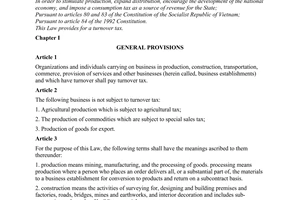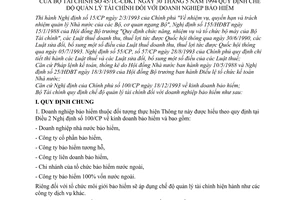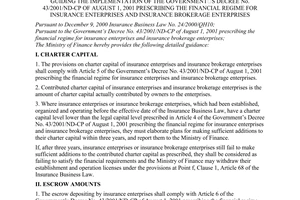Circular No. 45/TC-CDKT stipulating the system of financial management đã được thay thế bởi Circular No. 72/2001/TT-BTC of August 28, 2001, guiding the implementation of The Government’s Decree No. 43/2001/ND-CP of August 01, 2001 prescribing the financial regime for insurance enterprises and insurance brokerage enterprises. và được áp dụng kể từ ngày 16/08/2001.
Nội dung toàn văn Circular No. 45/TC-CDKT stipulating the system of financial management
|
MINISTRY
OF FINANCE |
SOCIALIST
REPUBLIC OF VIET NAM |
|
No. 45/TC-CDKT |
Hanoi, May 30th,1994 |
CIRCULAR
STIPULATING THE SYSTEM OF FINANCIAL MANAGEMENT FOR INSURANCE BUSINESS ENTERPRISES
In compliance with Decree
No.15/CP dated 2nd March 1993 of the Government on "The functions, rights
and obligations on the state management of the Ministries and Ministry ranking
bodies", Decree No. 155/HDBT dated 15 Jan, 1988 of the Council of
Ministers stipulating "The functions and organization of the Ministry of
finance", the Law on Profits and Turnover Taxes passed by the National
Assembly on 30 June 1990; the Law on Amendment and Addition to a number of
articles of the La w on Profits and Turnover Taxes passed by the National
Assembly on 5th July 1993; Decree No.55/CP and 57/CP dated 28 August 1993 of
the Government stipulating detailed execution of the Laws on Taxes and the Laws
on Amendment of and Addition to a number of article of the Law on Taxes.
Pursuant to the Ordinance on Accounting and Statistics issued by the State
Council on 10th May 1988 and the Decree No.25/HDBT dated 18th March 1989 of the
Council of Ministers on the regulations for the state accounting organization.
Pursuant to the Governmental Decree No.100/CP dated 18th Dec, 1993 on insurance
business.
The Ministry of finance hereby stipulates the system of financial management
for insurance business enterprises as follows:
I. GENERAL PROVISIONS
1. Objects implementing this circular are the business enterprises understood in the concept noted in Article 2 of the Decree No.100/ CP on insurance business and include:
- State run insurance enterprises
- Share holding insurance companies
- Mutual insurance companies
- Joint venture insurance companies
- Affiliates of foreign insurance organizations
- Insurance companies with 100% foreign owned capital
Particularly for insurance brokerage organizations the system of financial management, valid at present for other service companies, shall be applied
2. The insurance enterprise is a self-supporting economic unit which is independent in financial aspect, physically responsible for its business operations and liable to fulfill all obligations to the State of Vietnam in accordance with the laws.
3. Any state owned enterprise operation in field of insurance business should firstly comply the financial systems commonly set forth by the state for other state owned enterprises such as system of the safety and increase of funds, system of plan making, plan implementation reporting and financial balancing of enterprises etc....then the terms of this circular.
II. CAPITAL, DEPOSIT FOR SECURITY, FINANCIAL SOLVENCY
1. Capital
1.1 The legal capital applied to insurance enterprises is stipulated in Article 22 of the Decree on insurance business. An Insurance enterprise may set forth its prescribed capital higher than legal capital that will increase during operation.
1.2 Insurance enterprises are liable to keep their funds safe and increasing. for the state owned insurance enterprises, this will be in compliance with common regulations dedicated to the state owned enterprises of all kinds.
2. Deposit for security
2.1 The insurance enterprise must pay a deposit as security money and shall enjoy the interest of that deposited amount as stipulated in Article 9 of the Decree 100/CP on insurance business. The deposited volume is stipulated in circular No. 46TC/CDTC dated 30 May 1994 of the Ministry of finance on guidance for implementing the decree No. 100/CP.
2.2 In case the financial solvency is deficient, the Insurance enterprise is entitled to spend the deposited money meeting the demand for unplanned settlement. Within 90 days after spending the deposited money the enterprise must repay the deficit of the deposited amount and report on this to the Ministry of finance.
2.3 Terminating business operation, the Insurance enterprise is entitled to withdraw its deposited amount completely
2.4 After paying deposit, the insurance enterprises must report to the Ministry of finance. Any case of spending money from the deposited amount should be agreed to by the Ministry of finance in written form.
3. financial solvency.
3.1 The Insurance enterprise must keep being solvable during its operation.
3.2 a) An Insurance enterprise is considered to be solvable if the sum of the following capital resources is larger than or equal to the rate of guarantee solvency:
- The paid prescribed capital.
- The compelling reserve fund (as stipulated in Article 11 of the Decree No. 100/CP on insurance business)
- Unused benefits of the previous years
b) The rate of guarantee solvency is stipulated as follows:
b1. for the non life insurance enterprises: 20 %, the insurance premium actually kept in the last fiscal year
b2. for the life insurance enterprises 0.1% the insurance money collected through insurance contracts that valid in the last fiscal year.
b3. for the insurance enterprises operating in both life and no life insurance equal to the sum of b1 and b2.
3.3 If the solvency is not guaranteed the insurance enterprise should draw up a financial alternative to cover the deficit and report on this to the Ministry of finance the financial solution should be carried out within 90 days after discovering the deficit of solvency
- In case the solvency could not be recovered completely as required above, the Ministry of finance shall make a decision on suspending the operation of the insurance enterprise until the guarantee solvency is satisfied.
- When the solvency is so seriously deficient that total resources, noted in point 3.2(a) above, is less than one third the guarantee solvency, the Ministry of finance shall withdraw the Certificate on sufficient criteria and conditions for doing insurance business as stipulated in Article 24 of the Decree on Insurance Business.
III. BUSINESS RESERVE
1. Business reserve is a reserve amount relating to each insurance transaction which is established and accounted as business expenditures in order to settle with fixed in or arisen from the signed insurance contracts responsibilities.
2. Business reserve must be provided for each insurance transaction and established only for that responsibilities kept by the insurance company. The balance of the business reserve at the fiscal year end shall be carried forward to be the opening balance of the business reserve for the next fiscal year.
3. The Insurance enterprise must set up the following business reserves:
3.1 Reserve premium for unfulfilled responsibilities (or as called reserve premium)
- for the non life insurance business: reserve premium comprises these insurance premiums collected in the current fiscal year that is deducted in anticipation for settling with the responsibilities arising in following years when the insurance contract is still valid. The reserve premium is equal to the retained premium of the last 2 months for the insurance for transportation by land, by sea, by river, by train and by air and 40% the total retained premium of the last fiscal year f or the other types of non-life insurance. The other method of calculation of the reserve premium must be reported to the Ministry of finance and shall only be applied with a written agreement of the Ministry.
- for the life insurance business: the reserve premium comprises saving fees to be accumulated for the insurance balance of deposits. The reserve premium is calculated by suitable mathematical methods of international practice.
3.2 Reserve compensation for unpaid claims (or as called the Reserve compensation): This is a reserve for compensating the insured losses that have been occurred but still pending at the fiscal year end whether they are claimed or not. T his reserve is calculated by the statistical methods.
3.3 Reserve compensation for large-scale fluctuation of losses (or as called large scale fluctuation reserve): This is for compensating the cases when large scale fluctuation of losses or great losses occur and the total premium retained after the deduction to the reserve premium and the reserve compensation of the fiscal year is not enough for paying the compensation. The deduction to large scale fluctuation reserve is calculated by the statistical methods and should be taken every y ear until this reserve reached 100% the actually retained premium of the fiscal year.
IV. REVENUES AND EXPENDITURES
1. Revenues:
1.1 Insurance Business Receipts include:
a) The receipts of original insurance premiums
b) The receipts of re-insurance business include:
- The receipts of re-insurance premiums
- Other receipts
c) The receipts of concessive re-insurance business include :
- Commission for re-insurance concession
- Compensation for re-insurance concession
- Other receipts
d) Balance of the business reserves of the last year to be carried forward:
- Reserve premiums
- Reserve compensation
e) The receipts claimed from the third party
f) Other receipts: evaluation fees, settlement with 100% compensated goods etc.
1.2 Investment and other operations revenue include:
a) Benefit of investment activities
b) Revenue from other operations include:
- Bank interest (of non-invested capital)
- Other fees collected from: Evaluation agent, compensation consideration, claiming the third party etc.
- Other receipts
2. Expenditures
2.1 Insurance business expenditures include:
a) Reimbursement of original insurance premiums
b) Compensation of original insurance includes:
- Indemnification for insurance responsibilities
- Indemnification for concessive re-insurance responsibilities
c) Expenditures for conceded re-insurance include:
- Commission for conceded re-insurance
- Indemnification for conceded re-insurance
- Other expenses
d) Expenditures for re-insurance concession:
- Re-insurance concessive fees
- Other expenses
e) Deductions to business reserves : that include
- Reserve premium
- Reserve compensation
- Large scale fluctuation Reserve
g) Expenditures for business operation include:
- Expenses for depreciation of the fixed assets
- Expenses for wages, salaries and other payment, given to the laborers in compliance with the valid regulations
- Expenses for taxes and fees, stipulated by the state
- Expenses for the safety and increase of funds (in respect to state-run insurance business enterprises)
- Other expenses for management
h) Expenses for original insurance commission
i) Other expenses for: evaluation, settlement with 100% compensated good etc.
2.2 Expenditures for investment and other activities:
a) Investment expenses (excluding original capital to be invested)
b) Expenses for other operations include:
- Bank operations expenses
- Expenses for: Evaluation agent, compensation consideration, claiming the third party.
- Expenses for taxes and fees, stipulated by the state
- Other expenses
3. The insurance enterprise is not allowed to entry the following items into expenditures:
a) The deduction to the compelling reserve fund as stipulated in Art.11 of the Decree on insurance business
b) Penalties of different kinds to be paid for the violation of the state regulations, the contracts or for the overdue debts etc.
c) Losses of public properties, caused by the individuals or collective of the insurance enterprise
d) Expenses for shopping of the fixed assets, capital construction, taken from capital construction resources (for the state-run insurance enterprises)
e) Expenses, which are funded by other resources.
V. CAPITAL INVESTMENT
1. The Insurance enterprise is entitled to invest its idle resources. The following capital resources can be invested:
- Prescribed capital
- The compelling reserve fund
- The business reserves
2. The capital taken from the business reserves (that is the resources which are respective to the agreements between the insurance enterprise and the insurance) will be entitled to be invested in Vietnam and for the followings:
a) Buying the state loans, treasure bonds
b) Doing business in real estate
c) Buying stocks (share coupons, bills etc.)
d) Making capital contribution to joint ventures
e) Giving loans in accordance with the ordinance on Banks, credit cooperatives and financial companies dated 23 May 1990
f) Making interest deposit at Banks, credit organizations or the state treasuries. Capital, invested to each item (except the item f) must not exceed 25% the business reserves.
3. The investment of the above - mentioned resources should satisfy the following principles:
- Maximum security
- Satisfying regular settlement
VI. OBLIGATIONS TO THE STATE BUDGET
The Insurance enterprise is liable to sufficient and timely payment to the state budget of the following items:
- Turnover tax, profits tax, patent dues, land and building tax and the receipts from the utilization of budgetary capital (for the state-run insurance enterprises)
- Capital depreciation of the fixed assets in compliance with the state regulations (for the state-run insurance enterprises)
- Other payments in compliance with the valid at present regulations
- Obligations to the payment for duties are stipulated as follows:
1. Turnover tax:
1.1 The taxable turnover is calculated as follows:
- Original insurance premiums collected from the insured individuals and organizations
- Conceded re-insurance premiums
- Receipts from real estate business, giving loans in accordance with the ordinance on Banks, credit collectives and financial companies.
- Receipts from evaluation agent, compensation and claiming the third party
- Receipts from other activities.
1.2 Tax rates to be applied are stipulated in art.4 of the Decree No. 55/CP dated 28 August 1993 and the attached turnover tax tariff.
2. Profits tax
2.1 The taxable profit include the profits gained from insurance business investment and other operations that is determined as follows:
Taxable profit = (Insurance revenue - Insurance expenditures) +
+ (Investment and other revenues -
- Investment and other expenditure)
The above mentioned revenues and expenditures are calculated as follows:
- Insurance business revenue: shall include that of heading 1.1 (minus) the receipts of compensation for re-insurance concession, noted in 1.1 (c) part IV of this circular.
- Insurance business expenditure: shall include that of heading 2.1 indemnification for concessive re-insurance responsibilities, noted in 2.1(b) and expenses for payment of profits tax, noted in 2.1 (g) part IV of this circular.
- Revenues from investment and other operations: shall include that of heading 1.2 part IV of this circular.
- Expenditures for investment and other operations: shall include that of heading 2.2 expenses for payment of profits tax, noted in 2.2 (b) part IV of this circular
2.2 Tax rate is determined as follows:
- for joint venture Insurance companies, affiliates of foreign Insurance organizations, Insurance companies with 100% foreign owned capital: tax rate is calculated in compliance with the Clause 26 of the Law on foreign Investment in Vietnam.
- for share holding insurance companies and the state-owned insurance enterprises : in compliance with art.5 and 6 of the Decree No.57/CP dated 28 August 1993 of the Government.
- Provision for the procedures and time of tax payment, tax exemption and reduction are in compliance with the Law on turnover and profits taxes and other legal documents concerned.
3. Patent dues : in compliance with Resolution No.226/HDBT dated 19 October 1991 of the Council of Ministers and circular No.64/TC-TCT dated 28 February 1991 of the Ministry of finance..
4. Land and building taxes: in compliance with Ordinance on land and building taxes dated 31 July 1992, Decree No.339/HDBT dated 22 Sept. 1992 of the Council of Ministers and the valid at present legal documents concerned.
5. Payment for the utilization of budgetary capital:
This payment is imposed only on the state-owned insurance enterprise and in compliance with Decree No.22/HDBT dated 24 January 1991 of the Council of Ministers, the circulars No.13/TCT dated 28 February 1991 and No.89/TC/TCT dated 31 December 1 993 of the Ministry of finance.
VIII. ACCOUNT SYSTEM
The insurance enterprise is liable to undertake the account system, complying the provisions of the Ordinance on accounting and statistics of Vietnam, Decree No.25/HDBT dated 18 March 1989 of the Council of Ministers and circular No.03/TC-VKH dated 17 February 1992 of the Ministry of finance
Besides that :
1. Each quarter, not later than the 40th day of the next quarter, the Insurance enterprise has to submit to the Ministry of finance the following reports (to be made in generally established forms of the Ministry of finance) :
- Report on the collection of insurance premiums
- Report on the insurance indemnification
2. Every year, not later than the 1st March of the next year, the insurance enterprise has to submit to the Ministry of finance the following reports (to be made in generally established forms of the Ministry of finance):
- Report on the collection of insurance premiums and on the reserve premium
- Report on the insurance indemnification and on the reserve compensation
- Report on the deduction to the large scale fluctuation reserve
- Report on the investment operation, relying on the business reserved resources
- Report on the insurance business operations
- Report on business profits and losses
- Report on the financial solvency
- Report on the balance of assets
IX. PROVISIONS FOR IMPLEMENTATION
1. The Insurance enterprise is responsible to the Laws for all its business operations and must fulfill all responsibilities that have been agreed to by insurance contracts and the obligations to the state budget in time and sufficiently.
2. The Insurance enterprise must be under the management, control and inspection of the Ministry of finance in compliance with the Law on Taxes. Ordinance on Accounting and Statistics, Ordinance on Inspection, Ordinance on the Administrative settlement and the Government's Decree on Insurance business.
3. This Circular shall go into effect from 01 Jan 1994 instead of the Circular No.26/TC/TCDN dated 14 July 1989 of the Ministry of finance.
4. The Insurance enterprise is responsible for sending its internal documents guiding the implementation of this Circular to the Ministry of finance
If any problem arise from the implementation, please immediately report of the Ministry of finance for timely consideration and making necessary additions and amendments.
|
|
FOR
THE MINISTRY OF FINANCE |




